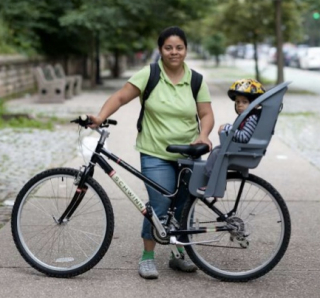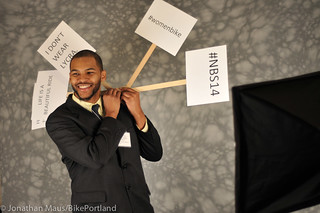—BikePortland’s coverage from Washington D.C. is made possible by Planet Bike.
Each year as I fly home from the National Bike Summit I think back to what trends and topics left the biggest impression. There are so many threads weaving through the bike movement right now that it’s hard to pick out just a few. That being said, below are my key takeaways from this year’s Summit…
People who love bicycles — especially those who advocate on their behalf for a living — tend to be a passionate lot. Because of that, every problem is approached with bicycling as the default cure. Bikes are such a potent force that surely, once everyone avails themselves to their power, they’ll adore them just as much as we do.
Unfortunately, that approach often backfires.
“If you want more women to bike, don’t put bikes at the center of your analysis; put women at the center of your analysis.”
— Terry O’Neill, National Organization for Women
As bicycling has begun to move beyond the usual suspects in America, advocacy groups and project planners are finding out — sometimes the hard way — that not everyone sees bicycling as the cure-all. This isn’t to say that the case for bicycling isn’t strong. It’s a wonder-drug if there ever was one. But there’s seems to be a growing awareness that cycling might make more gains if the argument was “re-centered.” Terry O’Neill, the president of the National Organization for Women had one of the most repeated quotes of the summit when she said (and I paraphrase), “If you want more women to bike, don’t put bikes at the center of your analysis; put women at the center of your analysis.”
O’Neill is talking about a subtle, yet important shift in perspective. Here’s what I think she means:
It’s the difference between a bike company offering a line of “women’s bikes” that are just pink and small versions of the men’s bikes, versus actually asking women what they want. Or, it might be the difference between entering a neighborhood with a “bike project” to cure street ailments, versus starting an honest conversation about how the street is used, what its users think needs fixing, and what tools should be used to do the work.
Put another way, instead of seeing a problem — like an unsafe road (where a new bikeway might help) or a social/community issue (like a lack of bicycling in hard-to-reach communities) — and instantly putting forward biking as the savior; go into the process with biking in your back pocket. Then, listen to the perspectives and issues of other people around the table and ask them if they think bicycling could be part of the solution. If they do, you’ll have arrived at that destination in a much more collaborative way and the next steps will be much more fruitful. If they don’t, then you can learn their concerns and hopefully work through them together. Either outcome will lead to more productive and peaceful results.
“If you have to explain something, you’ve already lost.” I don’t recall who said that at the Summit, but they were talking about the limitations of statistics in making the case for cycling. Instead, storytelling is often more effective. From videos to photos to hashtags spread across many different mediums, advocates are realizing that stories can have more impact than statistics. The Summit agenda reflected the rise in storytelling with sessions titled, “The Power of Storytelling,” “Streetfilms U,” and “Video Advocacy.”

presentation by Aaron Naparstek)
And we learned about many real-life examples..
When advocates in New York City were faced with the most powerful bikelash in American history (a congressman and a network news anchor teamed up to fight a bikeway in Prospect Park), they fought back. Their main weapon didn’t include an angry defense of cycling or stats and studies proving the merits of the bikeway. Instead, the turned to photographs. They enlisted a photographer (in this case Dmitry Gudkov) who published a series of portraits of normal, everyday people using the bikeway. While the opposition tried to paint users of the bikeway as eccentric hippies, and even terrorists (seriously), these images proved otherwise.
Another example came from the Boston Cyclists Union. They were very concerned that bikeways weren’t being prioritized following a snowstorm. The response from MassDOT was that no one bikes in winter anyways, so why plow them? To prove them wrong, advocates simply started posting photos to social media along with the hashtag #winterbike. The campaign worked.
The rise of storytelling is likely linked to the growing power of social media where it’s much easier to get something visual to go viral. It might also be due to the maturation of advocates who are starting to see the limits of statistical brow-beating. And ask yourself what stoked your first love of cycling — I bet it had nothing to do with numbers or charts.
For the last few years, the League has assured Summit attendees that the bike movement was a force to be reckoned with. But given the bruises to biking in the last transportation bill and the lack of any major policy victories, those assurances seem more like empty pep rally cheers rather than a reflection of reality. Now, as Congress works on the next transportation bill, it finally feels like bicycling is going to get its seat at the grown-ups’ table.
I could be wrong on this, but my hunch is based on several things…

Executive Director, and consummate advocacy
professional, Alison Graves.
(Photo by J. Maus/BikePortland)
Advocates have, frankly, gotten their shit together. Karen Brooks, the former editor of Bicycle Times Magazine, told me she remembers being at past Summits where advocates had to be reminded several times to dress nicely on the Lobby Day. “No spandex!” someone from the League would implore. Today, there’s no spandex to be seen anywhere. America’s bike advocates are looking sharp and they’re ready for business. The League deserves all the credit for this. In hosting the Summit for so many years, they’ve created an army of well-dressed, well-prepared, and well-spoken lobbyists who are slowly but surely making an impression on Congress.
When I asked League President Andy Clarke what stood out to him after yesterday’s lobbying efforts, he said more members of Congress than usual wanted to be present in the meetings. With dozens of lobbying meetings every week, lobby groups usually meet with a legislative aide, not the actual member. If these busy and powerful electeds are starting to deem bike groups worthy of face-time, that’s a very positive sign.
Another example came from opinion researcher Douglas Meyers. He conducted dozens of confidential interviews with mayors to find out what they really think of bicycling in cities. “The extent of acceptance of this concept really bowled us over,” Meyer reported. What’s behind this embrace of cycling? A lot of factors; but economic development and cities trying to attract millennials has a lot to do with it. The widespread adoption of bike share systems in many major cities — and the rise in trips and biking awareness that always follows — could be another factor.
*Taken from quote by Rep. Earl Blumenauer.
___
These are just a few of my takeaways from the Summit. There are definitely others that deserve to be mentioned (I’ll share more about the burgeoning equity movement in a separate post); but I’ll leave it at that for now. Were you at the Summit? What major themes stood out for you?
— Hope you’ve enjoyed coverage from D.C. You can browse the rest of it here.







do we really thing LBSs and serious manufacturers are still just painting stuff pink for women who want to ride? Sad if that’s true. I was under the impression that they’re putting a lot of effort into getting away from that meme.
http://www.trekbikes.com/us/en/collections/womens
meanwhile… here’s the pink bike:
http://25.media.tumblr.com/0254d127b9e895c0f446c55641d25d90/tumblr_mr8pb0nyjZ1rlmfrlo1_1280.jpg
As an industry member I think shrink ‘n pink is still a common ploy. At the risk of severe incoming though, I think the gender hand is a bit overplayed. It’s not so much that the the bike world doesn’t cater to women as it doesn’t cater to non sport/race riders of any gender or age. Women who are into lycra world and cycling as sport/hobby are nowadays catered to almost as well as men. But we already know that when infrastructure allows many more women will start riding bikes. In parts of the world where many more women ride I don’t think you see that much more marketing/messaging etc to women per se. What you DO see is more routes to ride that are safe and sane, where you’d take a child or mother or try a ride even if feeling a little timid or inexperienced. And you will see MANY more bikes with mudguards, chainguards, racks, pumps, lights and bells and upright city bike proportions.
Put these elements in play and guess what? Women will appear everywhere miraculously on bikes. Of course this is America so everything has to be about marketing, conveying imagery, wooing with manipulation and more, but sometimes the actual streak is more important than the sizzle. (apologies to vegetarians 😉 As long as we perceive the bike as a weekend/after work toy and create an environment that for cycling that draws pretty much only the fast and furious, it will appear to be male dominated. How many women do you see on superfast street motorcycles? Some of course but very few. It’s our own cultural prejudices about the role of the bicycle that pushes it to the male end of the gender spectrum here in the US.
As a shameless plug for some of the work we’ve been doing on Scenic Bikeways, just wanna throw out that we’ve been super conscious about points 1 and 2 when creating marketing images and video around bicycle tourism in the state. We’ve intentionally incorporated women doing rad things and reframing bike travel and adventure outside the usual stereotypes.
http://pathlesspedaled.com/2014/03/biketourism-not-your-typical-womenbike-marketing/
Russ
Love this perspective. Yes! Listen and be led is a good rule of thumb for any movement trying to reach beyond its current membership.